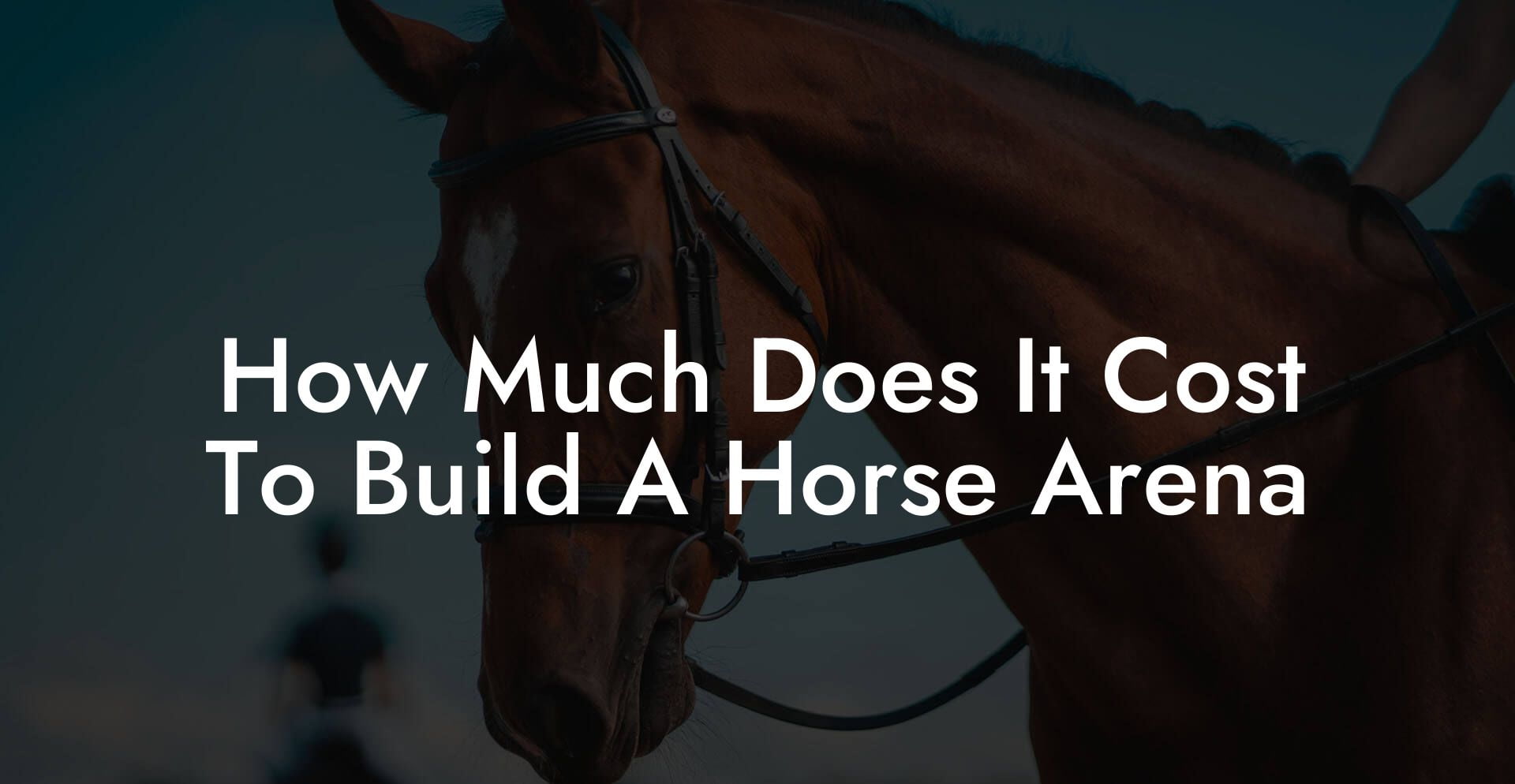Building a horse arena isn’t just about erecting a structure, it’s about carving out a dynamic space where equine dreams and rider ambitions collide. Whether you’re planning weekend trail rides, horse competitions, or simply a safe haven for your four-legged friend to kick up dust, understanding how much it costs to build a horse arena is key to transforming your vision into a reality. Think of it as investing in a playground for your equine superstar.
Quick Links to Useful Sections
- Understanding the Big Picture: What’s Involved in Building a Horse Arena?
- Key Factors Influencing the Cost of Building a Horse Arena
- Size and Dimensions
- Surface Material Choices
- Fencing and Safety Features
- Lighting, Drainage, and Infrastructure
- Permits, Labor, and Local Regulations
- Breaking Down the Costs: A Comprehensive Look at Your Investment
- Site Preparation and Groundwork
- Material Costs: Footing, Fencing, and Beyond
- Labor and Construction Expenses
- Smart Budgeting and Financing: Making Your Horse Arena a Reality
- Budgeting Tips for Your Project
- Financing Options to Consider
- DIY vs. Professional Services
- Comparing Various Horse Arena Designs and Their Price Points
- Traditional Outdoor Arenas
- Covered or Indoor Arenas
- Multi-Functional Arenas
- Hidden Costs and Unexpected Expenses: What to Watch Out For
- Case Studies: Real-World Examples of Horse Arena Construction
- The Community Equestrian Center
- High-End Private Training Facility
- A Multi-Functional Event and Riding Arena
- Environmental Impact and Sustainability Considerations
- Eco-Friendly Materials
- Sustainable Water and Drainage Solutions
- Energy Efficiency
- Maintenance and Long-Term Investment: Caring for Your Arena
- Routine Maintenance Tasks
- Long-Term Upgrades
- Resources and Community Support: Your Next Steps
- Equestrian Forums and Social Media Groups
- Local Equestrian Organizations
- Professional Consultants and Architects
- Grants and Financial Assistance
- The Future of Horse Arenas: Trends and Innovations
- Technological Advancements
- Sustainable Designs
- Multi-Use Functionality
- Frequently Asked Questions (FAQs)
- Your Journey Begins Now: Bringing Your Horse Arena Vision to Life
Understanding the Big Picture: What’s Involved in Building a Horse Arena?
When it comes to building a horse arena, there are many moving parts (just like the horses you care for!). From choosing the right materials to complying with local regulations, every decision can significantly affect the final cost. This guide dives deep into each aspect of arena construction, providing you with a no-nonsense breakdown of the expenses involved, tips for smart budgeting, and insights on creating a versatile, long-lasting arena. Whether you’re a seasoned equestrian or just beginning your journey, we’ve got you covered with down-to-earth advice and a dash of humor.
Before you break ground, it’s essential to understand that the cost to build a horse arena can vary widely. Factors such as size, surface material, fencing and lighting, drainage systems, and even labor charges vary from place to place. With our holistic approach, you’ll be equipped to navigate the complexities of construction while ensuring your budget, and your horse’s happiness, remain intact.
In the sections below, we’ll tackle everything from basic costs to hidden extras that could spring up along the way. Buckle up and prepare your notepad, this ride through arena construction costs is both informative and entertaining!
Key Factors Influencing the Cost of Building a Horse Arena
The price tag of your horse arena is determined by a mix of factors. Understanding these can help you plan with confidence and avoid unexpected expenses. Let’s break down the main drivers:
Size and Dimensions
One of the first considerations is the overall size of your arena. Larger arenas require more materials and labor, naturally increasing the cost. A typical riding arena might range from 20,000 to over 70,000 square feet depending on its intended use (training, competitions, or both). Consider not only the performance area but also stables, viewing areas, and storage sheds.
Surface Material Choices
The heart of a horse arena is its footing, or surface material. Options include:
- Sand: A popular choice for its cushioning properties, sand must be mixed with other materials to prevent compaction.
- Arena Footing Mixes: Special blends of sand, rubber, and fiber that provide a firm yet forgiving surface.
- Acrylic or Synthetic Surfaces: These are engineered for durability and require less maintenance, though initial costs may be higher.
The type of surface you choose will depend on your intended use and how much maintenance you’re willing to handle. Each option has its own cost implications in terms of initial installation and long-term upkeep.
Fencing and Safety Features
Safety is paramount when working with horses. A sturdy fence is essential for keeping your equine athletes safe and contained. Costs here can include:
- Perimeter Fencing: Options vary from traditional wood and barbed wire to modern PVC or mesh fences, each differing in style, durability, and price.
- Gates and Access Points: Ensure there are secure entry and exit points, along with adequate signage and emergency exits.
These features not only protect your horses but also contribute to the overall aesthetic appeal of the arena.
Lighting, Drainage, and Infrastructure
To maximize usability, regular maintenance and additional infrastructure improvements are key:
- Lighting: Installing adequate lighting allows for safe nighttime riding and training sessions. Expect higher costs for robust LED systems with proper wiring and controls.
- Drainage Systems: Proper drainage is critical to prevent waterlogging and damage to the arena surface. This includes grading, installation of drains, and sometimes even septic systems.
- Infrastructure: Additional amenities like covered storage, benches, and even sound systems can add extra flair (and cost) to your project.
Each of these elements contributes not only to the functionality and safety of the arena but also to its overall cost and long-term value.
Permits, Labor, and Local Regulations
Last but not least, don’t forget the “hidden” costs: permits and labor. Construction and zoning permits are mandatory and vary by municipality. Hiring skilled contractors and ensuring that work complies with local building codes is essential. This means investing in professionals who not only execute the project flawlessly but also ensure that you’re in the clear with local authorities.
With these variables in mind, planning your horse arena becomes not just a design exercise but a financial strategy. Mapping out costs early on can save you headaches, and dollars, later.
Breaking Down the Costs: A Comprehensive Look at Your Investment
Now let’s get into the nitty-gritty: the specific costs associated with building a horse arena. We’re talking raw numbers, unexpected fees, and creative solutions to stretch your budget further.
Site Preparation and Groundwork
Every great arena starts with a solid foundation. Site preparation is a critical first step and can include:
- Land Clearing and Grading: Removing trees, rocks, and other obstacles to create a level building site. Depending on the topography, this can be one of the largest expenses.
- Initial Survey and Soil Testing: Conducting tests to determine whether the soil can support heavy foot traffic and horses running at full speed. Remediation or soil stabilization might be required, adding to costs.
- Utilities and Access Roads: Creating access roads and connecting utility lines, if not already available, is another labor-intensive phase that can significantly drive up costs.
Cost estimates for site preparation vary greatly, anywhere from a few thousand dollars for a small, flat lot to tens of thousands for more challenging terrains. It’s wise to budget generously for any unforeseen complications.
Material Costs: Footing, Fencing, and Beyond
The materials used for your arena are the backbone of your investment. Let’s break down individual components:
-
Footing Materials:
The surface of your arena is arguably the most critical element. A basic sand footing might be less expensive initially, but specialized footing mixes can run significantly higher. Expect to spend anywhere from $2 to $10 per square foot depending on the materials and depth required.
-
Fencing and Gates:
High-quality fencing is essential for safety. Costs can range from $15 to $50 per linear foot, depending on the type of material. Modern alloys or composite fences, while pricey upfront, often provide better durability and lower maintenance costs in the long run.
-
Lighting and Electrical Work:
For those who plan to host events or train during the evening, investing in a robust lighting system is non-negotiable. Installation of LED lights, wiring, and switches might add several thousand dollars to your budget, typically between $3,000 and $10,000.
-
Ancillary Structures:
Don’t overlook additional structures such as storage sheds, stables, or spectator areas. These can vary widely in cost, with custom designs and high-end finishes costing significantly more.
Keep in mind that prices for materials are constantly fluctuating, influenced by market demand and economic conditions. It’s always a good idea to consult with multiple suppliers for up-to-date pricing.
Labor and Construction Expenses
Skilled labor can account for a large percentage of your total budget. Here’s why:
-
Contractor Fees:
Hiring a reputable contractor is critical. Professional fees usually fall between 10% and 20% of your total project cost. This fee covers project management, skilled labor, and contingency planning.
-
Specialized Work:
Beyond general labor, some aspects of arena construction require specialized skills. For example, installing drainage systems or precision-grade footing materials might necessitate experts, thereby increasing costs.
-
Unexpected Expenses:
Always include a contingency in your budget, typically 10% to 15%, to cover unforeseen challenges. Whether it’s a delay due to weather or unexpected issues with the soil, having a financial buffer can keep your project on track.
While labor costs are harder to predict precisely, obtaining detailed quotes and checking references can help you manage and anticipate the expenses.
Smart Budgeting and Financing: Making Your Horse Arena a Reality
With a clear understanding of the variables affecting costs, the next step is creating a solid budget and exploring financing options. Here are some strategies to keep your project financially sound:
Budgeting Tips for Your Project
Start by outlining all the potential costs, from site preparation to the final finishing touches. Use a detailed spreadsheet to track each expense category and don’t forget to include a contingency fund for unforeseen issues. Keeping detailed records will not only help you stay on track but also allow you to adjust plans as needed without blowing your budget.
Financing Options to Consider
Not everyone has enough savings lying around to cover a major construction project outright. Consider these options:
- Bank Loans: Commercial or agricultural loans can provide the funds needed for large projects. Look for banks that specialize in equine or agricultural financing for competitive rates.
- Government Grants and Subsidies: Depending on your location, there might be grants available to support agricultural or rural development projects. Check with your local government for details.
- Private Investors: For larger projects, you might attract investment from local equestrian communities or private investors interested in supporting rural development.
- Partnerships and Sponsorships: Sometimes, local businesses or equestrian organizations are willing to sponsor your project in exchange for advertising or naming rights for parts of the arena.
Evaluate each option carefully and consider consulting with a financial advisor to select the best path forward for your unique situation.
DIY vs. Professional Services
While it might be tempting to cut costs by doing the work yourself, building a horse arena is a complex project that requires expertise in construction, landscaping, and equine facility design. This is one area where investing in professional services can actually save you money in the long run, ensuring durability, safety, and compliance with local codes.
In the end, budgeting smartly means not only tracking every dollar spent but also investing wisely in aspects that will yield longevity and safety for you and your horse.
Comparing Various Horse Arena Designs and Their Price Points
Versatility is key when planning a horse arena. The design you choose will heavily influence both functionality and cost. Let’s explore a few popular designs:
Traditional Outdoor Arenas
The tried-and-true outdoor arena is a favorite among equestrians for its open-air feel. These arenas typically offer:
- Cost Range: Moderate. Generally falls within a mid-range budget if basic materials and standard design layouts are used.
- Advantages: Plenty of space, natural ventilation, and a traditional feel that connects riders with the outdoors.
- Considerations: Weather exposure calls for high-quality drainage systems and maintenance of the footing to combat erosion and compaction.
Covered or Indoor Arenas
If you’re aiming for year-round riding and want to shield your horses from the elements, an indoor arena might be the way to go:
- Cost Range: High. The added expense of roofing, climate control systems, and better lighting tends to drive up the budget considerably.
- Advantages: Ideal for inclement weather, consistent footing conditions, and extended riding hours. Plus, it adds significant value to your property.
- Considerations: Must factor in the additional costs of heating, ventilation, and potential insulation to maintain a stable environment throughout the year.
Multi-Functional Arenas
These are arenas designed to serve dual or multiple purposes, for instance, combining riding space with event areas for shows or community gatherings.
- Cost Range: Variable. Multi-functional arenas can be on the higher end as they require integration of additional amenities.
- Advantages: Flexibility to host a range of activities; increases utilization and potentially offers avenues for revenue generation through events.
- Considerations: Planning and designing multi-functional spaces can be complex, often requiring specialized architects and custom builds.
Each design caters to different needs and budgets. Whether you prioritize cost-efficiency or long-term versatility, your chosen design should align with your equestrian lifestyle and future plans.
Hidden Costs and Unexpected Expenses: What to Watch Out For
Even the most meticulously planned budget can be derailed by unexpected costs. Here are some common areas where extra expenses might pop up:
-
Soil and Drainage Issues:
Even with detailed surveys, you may encounter unforeseen soil instability or drainage issues that require additional work or materials.
-
Permit Fees and Regulatory Costs:
Local regulations may impose extra fees or require modifications during the construction process, adding to your cost.
-
Site Accessibility Challenges:
Hard-to-reach construction sites may need specialized equipment, which can drive up labor and material transportation costs.
-
Maintenance Considerations:
Over time, the arena’s surface and infrastructure will need upkeep. Budgeting for regular maintenance and repairs is crucial to preserve your investment.
Before signing off on your budget, plan for these contingencies by incorporating a flexible reserve fund. A well-prepared budget can help you handle surprises without compromising on the quality of your arena.
Case Studies: Real-World Examples of Horse Arena Construction
Nothing brings the planning process to life like real-world examples. Here are a few case studies of horse arena builds to give you a tangible sense of what you might expect:
The Community Equestrian Center
In rural Kentucky, a community group pooled their resources to build a traditional outdoor arena. The budget was carefully managed by sourcing local materials, and volunteers contributed to the site preparation. While they faced unexpected drainage issues, the addition of a custom-made drainage system kept costs only moderately over budget. Today, the arena is a hub for community events, lessons, and weekend rides.
High-End Private Training Facility
A private training facility in California opted for a state-of-the-art indoor arena complete with LED lighting and climate control. Though the initial investment was steep, the long-term reliability and enhanced training conditions justified the expenditure. This project combined meticulous planning with high-quality materials to create a facility that caters to competitive riders all year round.
A Multi-Functional Event and Riding Arena
In Texas, innovation meets tradition with an arena that doubles as an event space. The build featured a flexible surface that can be reconfigured for different activities and integrated digital scoring systems. While the multi-functionality required higher upfront investment, the facility quickly became a revenue-generating venue for local shows, competitions, and community events.
Learning from these stories, you can see that building a horse arena is not a one-size-fits-all endeavor. Each project is as unique as the horses and riders it serves. Your final cost will reflect the choices you make, the local market conditions, and the unforeseen opportunities for creativity and improvement.
Environmental Impact and Sustainability Considerations
In today’s eco-conscious world, building a horse arena also means considering its environmental footprint. From responsible material sourcing to energy-efficient lighting and sustainable water management systems, there are ways to make your project green.
Eco-Friendly Materials
Opt for recycled or sustainably sourced materials wherever possible. For example, reclaimed wood for fencing or energy-efficient LED lighting not only reduces your impact on the environment but can also pay off in lower maintenance and operational costs over time.
Sustainable Water and Drainage Solutions
Consider incorporating rainwater harvesting systems or permeable pavement solutions in your design to manage water responsibly. Proper drainage is critical for both the longevity of your arena and maintaining a safe environment for your horses.
Energy Efficiency
If you’re installing lighting or climate control systems in an indoor arena, choose energy-efficient options. Solar panels, timers, and smart lighting systems can all contribute to a lower electricity bill and a more sustainable operation.
Incorporating sustainable practices into your build not only enhances your property’s value but also aligns with a growing movement toward environmental responsibility. It’s a win for both your wallet and our planet.
Maintenance and Long-Term Investment: Caring for Your Arena
Building a horse arena is a significant investment, but its value continues long after construction is complete. Regular maintenance is key to keeping your arena safe, functional, and looking great.
Routine Maintenance Tasks
Some of the routine tasks include:
- Surface grooming: Regularly grooming the footing to ensure evenness and proper drainage.
- Repairs: Fixing cracks, reapplying surface treatments, and addressing any wear and tear as soon as possible.
- Cleaning: Removing debris and ensuring that drainage systems remain unobstructed.
Investing in routine checks and maintenance plans can extend the life of your arena significantly, ensuring it remains a safe haven for your horses and a reliable space for training and events.
Long-Term Upgrades
As technology advances and your riding needs evolve, consider planning upgrades such as advanced lighting systems, improved surface materials, or enhanced drainage solutions. These upgrades not only increase the functionality of your arena but also help maintain its value over time.
Keep in mind that the upkeep of your arena is a continuous process. Scheduling regular inspections and maintenance can prevent small issues from becoming costly repairs, so think of it as a long-term investment in the safety and sustainability of your equine facility.
Resources and Community Support: Your Next Steps
Embarking on the journey to build your own horse arena may seem daunting, but you’re not alone. Countless resources and communities are available to support you every step of the way. Here’s how you can tap into these networks:
Equestrian Forums and Social Media Groups
Join online communities where enthusiasts share their experiences, DIY tips, contractor recommendations, and inspiration for building horse arenas. Platforms like Facebook, Reddit, and specialized equestrian forums are treasure troves of first-hand advice.
Local Equestrian Organizations
Reach out to local riding clubs, trainers, and equestrian centers. These organizations often have insights into regional costs, available grants, and trusted contractors who specialize in horse arena construction.
Professional Consultants and Architects
Consider hiring professionals who understand the specifics of equine facilities. Experienced architects and consultants can help you balance aesthetics, functionality, and budget, ensuring that your arena not only meets your current needs but also adapts to future demands.
Grants and Financial Assistance
Investigate government grants, local subsidies, or even private loans designed for agricultural and recreational facility development. Financial advisors who specialize in rural development can also provide tailored advice to keep your project financially viable.
The journey to building your horse arena is as much about community and shared expertise as it is about construction. Use these resources to connect, learn, and inspire your project.
The Future of Horse Arenas: Trends and Innovations
As equestrian sports and leisure riding evolve, so does the design and functionality of horse arenas. Innovations are reshaping how we think about these spaces, making them more adaptable, technologically advanced, and sustainable.
Technological Advancements
From automated climate control in indoor arenas to sensor-driven surface maintenance and mobile apps that monitor footing conditions in real time, technology is revolutionizing arena management. These new tools can help streamline maintenance, reduce energy costs, and improve safety and performance.
Sustainable Designs
With a growing focus on environmental responsibility, future arenas are incorporating more green building techniques. Think solar-powered LED lighting, eco-friendly materials, and innovative drainage systems that work in harmony with the environment.
Multi-Use Functionality
The trend towards multi-functional spaces continues to grow. Modern arenas may serve as venues for equestrian events, community gatherings, and even local markets, maximizing your return on investment while fostering a sense of community.
Staying informed about the latest trends not only ensures that you invest in a state-of-the-art facility, but it also allows you to future-proof your arena against evolving standards and emerging technologies.
Frequently Asked Questions (FAQs)
We know you’ve got questions about building a horse arena! Here are some of the most common inquiries we receive:
1. What is the average cost to build a horse arena?
The cost can vary widely depending on factors like size, surface materials, fencing, and additional features. On average, you might spend anywhere from $50,000 to over $250,000.
2. How does the type of footing affect overall costs?
Different footing types, from basic sand to advanced arena mixes, have varying installation and maintenance costs. High-quality footing mixes provide better performance and safety but typically come with a higher price tag.
3. Are permits and inspections a significant part of the budget?
Yes, permits, inspections, and compliance with local building codes can add a significant cost, often around 10-15% of the total project budget, depending on your location.
4. Can I build a horse arena myself to reduce costs?
While DIY options might appear to save money initially, constructing a horse arena is complex. Hiring professionals ensures proper design, structural integrity, safety, and compliance with local regulations.
5. What financing options are available for such a project?
Financing options include bank loans, government grants, private investors, and partnerships with local equestrian organizations. It’s a good idea to explore multiple sources to secure the best deal.
6. How often should I budget for maintenance after the arena is built?
Regular maintenance is crucial. Budget annually for routine upkeep, which could be around 5-10% of your initial construction cost, to keep the arena in top condition.
7. What are some hidden costs I should plan for?
Hidden costs can include unforeseen site preparation issues, additional permits, drainage and infrastructure upgrades, and long-term maintenance repairs.
8. How do I choose the right contractor for my arena?
Look for professionals with experience in equine facility construction, check references, obtain multiple quotes, and ensure they’re familiar with local building regulations.
9. What sustainable features can I incorporate into my arena?
Consider eco-friendly building materials, solar-powered lighting, energy-efficient climate control systems, and advanced drainage solutions that minimize soil disruption.
10. How do I determine the proper size for my horse arena?
The size will depend on your equestrian goals, whether for training, competitions, or multi-functional uses. Consult with experts on equine facility design to ensure you create an arena that meets your specific needs.
Your Journey Begins Now: Bringing Your Horse Arena Vision to Life
Crafting a horse arena is more than just an investment in property, it’s a commitment to creating a space where passion meets practical design, where every ride and every jump is backed by a solid foundation. From site preparation to selecting sustainable materials and ensuring proper maintenance, each step strengthens the overall vision of a safe, dynamic, and beautiful equestrian facility.
By carefully weighing each decision, from the type of footing to the style of fencing, you’re not just building an arena; you’re creating a legacy, a place where horses thrive and riders find their second home.
As you move forward, remember that every challenge is an opportunity to innovate and every decision is a step toward a future of endless riding adventures. Whether you’re planning a chic, modern indoor arena or a charming, traditional outdoor space, your commitment to quality and sustainability will shine through.
Embrace this journey with open arms and a ready toolkit of knowledge. With careful planning, a dedicated budget, and the support of experienced professionals and community networks, your dream arena is well within reach.
Now is the time to take those first steps toward building a horse arena that not only meets your current needs but also stands as a testament to your passion for equine care. Let your creativity soar, your horses gallop freely, and your arena become the backdrop for countless memorable rides and events.













